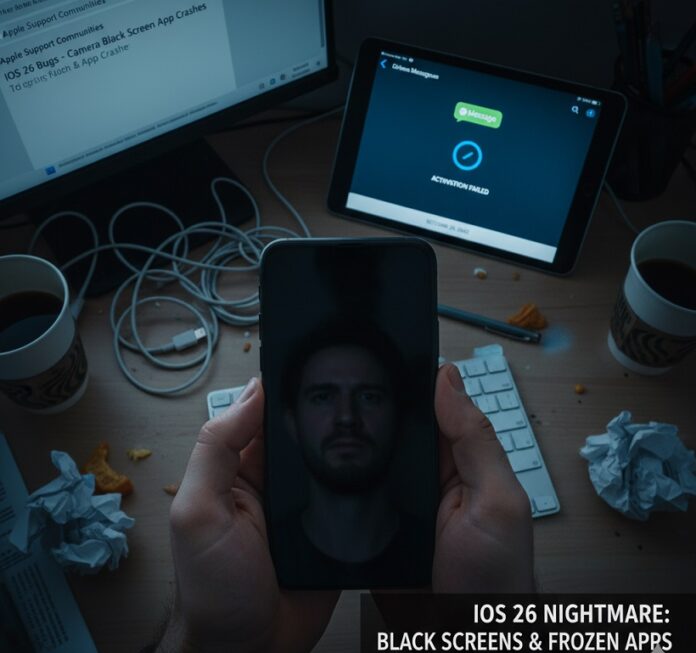If your iPhone’s Camera shows a black screen, or FaceTime and iMessage refuse to activate, you’re not alone. Since Apple rolled out iOS 26, many users across Apple’s support communities and social media have noticed built-in apps freezing, crashing, or failing to open entirely.
Reports describe the Camera app getting stuck on a black screen, iMessage not activating even after resets, and native apps like Mail, Contacts, or Calendar displaying blank screens. Some users also report that third-party apps crash immediately after the update is applied.
While the issues can be alarming, most are linked to software conflicts introduced during or after the iOS 26 upgrade. The good news is that several fixes have already worked for many users, and most don’t require a trip to the Apple Store.
Why Apps Fail or Crash After a System Update
Outdated caches, mismatched system frameworks, or corrupted configuration files often cause app instability after a major iOS update. During a version upgrade, the operating system rewrites critical components like permissions, storage indexes, and security certificates. If any of these processes get interrupted, the result can be apps that misfire or fail to launch.
On iPhone 17 models, several users suspect a deeper connection to Apple’s new background service management system, introduced with iOS 16 to optimize battery life. This system pauses or resets certain background tasks more aggressively, which may explain why Camera and FaceTime appear to freeze when switching modes or resuming from sleep.
Apple Support representatives on public forums have reportedly acknowledged that iMessage and FaceTime activation issues are affecting “a limited number of users” and that the company is preparing a permanent fix in an upcoming update.
Until then, there are reliable workarounds you can try right now.
Quick Fix: Install iOS 26.0.1
Before attempting manual troubleshooting, ensure your device is fully updated. Apple released iOS 26.0.1, a minor patch that mentions explicitly “fixes for app stability, camera behavior, and connectivity reliability.”
To update your phone:
-
Open Settings > General > Software Update.
-
Tap Download and Install if iOS 26.0.1 or later appears.
-
Restart your device after the update completes.
Many users have reported that updating immediately restored Camera and iMessage functionality.
Step-by-Step: How to Fix Failing or Crashing iPhone Apps
If problems persist after updating, follow these troubleshooting steps in order.
1. Force Quit and Relaunch the App
The most straightforward fix can clear temporary memory conflicts.
- Swipe up from the bottom of the screen and hold to open the app switcher.
- Swipe the problem app upward to close it completely.
- Reopen the app from the Home Screen.
This forces iOS to reload the app’s processes from scratch.
2. Restart Your iPhone
It sounds obvious, but a restart flushes memory and background tasks.
- Hold the power button and either volume button until the slider appears.
- Slide to power off, wait ten seconds, and turn the phone back on.
3. Check for App Updates
Outdated third-party apps may not be optimized for iOS 26.
- Open App Store > Account icon > Updates.
- Tap ‘Update All’ or update the affected apps individually.
Native Apple apps are updated through system patches rather than the App Store, so if the app in question is built-in (Camera, Mail, FaceTime), your only option is a full iOS update.
4. Reset All Settings
If multiple built-in apps are misbehaving, a settings reset often clears conflicts without erasing personal data.
- Go to Settings > General > Transfer or Reset > Reset > Reset All Settings.
- Enter your passcode when prompted.
This resets network preferences, keyboard dictionaries, display layout, and system permissions, but keeps your photos and apps intact.
5. Fix iMessage or FaceTime Activation Problems
If iMessage or FaceTime won’t activate after updating, try these steps:
- Go to Settings > Messages and toggle iMessage off.
- Go to Settings > FaceTime and toggle FaceTime off.
- Sign out of your Apple ID (Settings > [Your Name] > Sign Out).
- Restart your iPhone.
- Sign back in, then enable iMessage and FaceTime again.
Make sure you’re connected to a stable Wi-Fi or cellular network, and that your carrier supports iMessage activation. Activation can take up to 24 hours in some regions, especially after software updates.
6. Back Up and Restore from Scratch
If apps continue to crash, perform a full backup and then restore. This removes corrupted system files that may have carried over from older versions.
- Back up your iPhone using iCloud or Finder.
- On the device, go to Settings > General > Transfer or Reset > Erase All Content and Settings.
- Choose ‘Set Up as New iPhone’ rather than restoring immediately from a backup.
- Test whether Camera, FaceTime, and iMessage work.
- If they do, restore your data afterward.
This process takes time but resolves many deep-seated app issues.
7. Contact Apple Support
If none of these solutions work, hardware diagnostics may be needed.
- Contact Apple Support via chat or phone.
- Or schedule a Genius Bar appointment at your nearest Apple Store.
Rarely, Camera black-screen issues can relate to a failing image sensor or hardware connector. A diagnostic check will rule this out.
How to Prevent App Crashes in the Future
To minimize app instability after future updates:
- Avoid interrupting updates. Don’t force-quit or restart during system installation.
- Keep storage clear. Maintain at least 10% free space to prevent cache corruption.
- Restart weekly. This clears background tasks and refreshes memory management.
- Update apps regularly. Developers often patch compatibility bugs within days of iOS releases.
Small habits like these help prevent recurring crashes and sluggish performance.
Expert Perspective
Software engineers say that system migrations, such as iOS 26, can expose minor inconsistencies that only appear under real-world use. “Apple’s frameworks are extremely stable, but when you add third-party extensions or cached data from previous versions, you get unpredictable behavior,” notes mobile developer Ravi Bhatia, who specializes in iOS optimization.
He advises users to treat every major update as “a fresh start opportunity,” backing up, cleaning up old settings, and performing a quick reset if problems persist.
From a broader perspective, these issues highlight how deeply integrated Apple’s apps have become with core system services, such as authentication and networking. A small certificate glitch can ripple across multiple native apps simultaneously.
Case Study: One User’s Camera Glitch Fixed After Update
A user on Apple Support Communities described a persistent black screen when launching the Camera app on an iPhone 17 Pro. Force-quitting or restarting didn’t help. After installing iOS 26.0.1 and performing “Reset All Settings,” the app started working normally again.
The case highlights a recurring theme: software corruption rather than hardware defects is responsible for most app malfunctions after updates.
When to Suspect Hardware Issues
Although most failures are software-based, you should consider a hardware check if:
- The Camera app stays black even in Safe Mode.
- You hear clicking or feel heat near the camera lens.
- Apps crash immediately after opening, even after performing resets.
In those cases, Apple diagnostics can confirm whether the camera module, storage, or logic board needs service.
Summary: iPhone Apps Crashing on iOS 26
Try This First:
- Update to iOS 26.0.1.
- Force-quit and relaunch affected apps.
- Restart your phone.
- Update apps in the App Store.
If Problems Continue:
- Reset All Settings.
- Re-enable iMessage and FaceTime.
- Back up and restore your device.
- Contact Apple Support for diagnostics.
Most users find relief after the first few steps, especially following the 26.0.1 update.
The Bottom Line
App crashes after a big software update can be frustrating, but they’re usually temporary. For most iPhone 17 owners, installing Apple’s latest software update and resetting the settings typically resolves the issue quickly.
If iMessage or FaceTime still won’t activate, patience helps. Apple’s servers sometimes delay activation for a day or two after updates. And if Camera or built-in apps continue to misbehave, restoring your device from scratch nearly always clears hidden corruption.
Apple has a long record of addressing post-update instability swiftly, and with the right steps, your iPhone should return to normal operation without losing data.
















